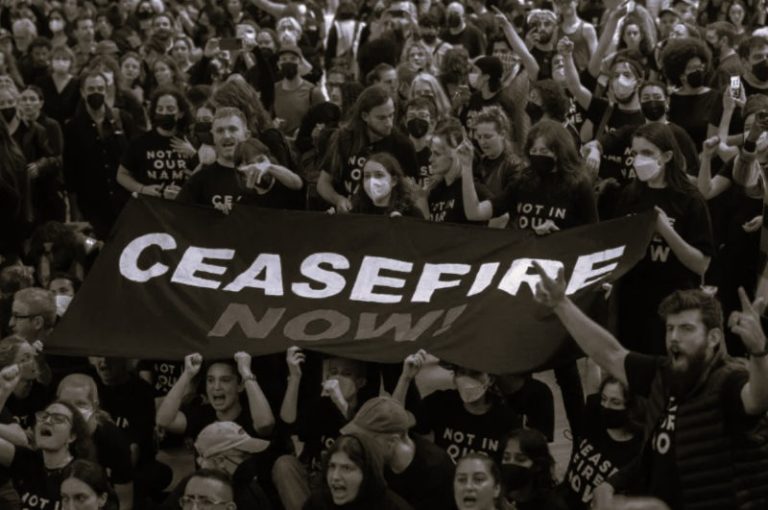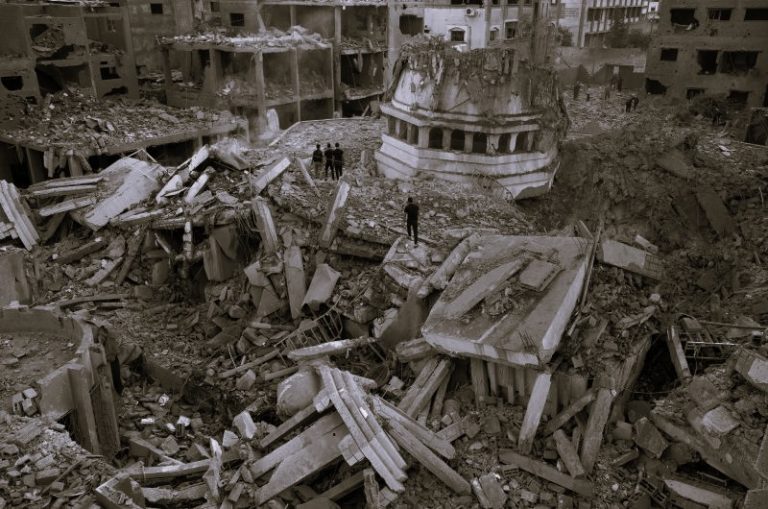
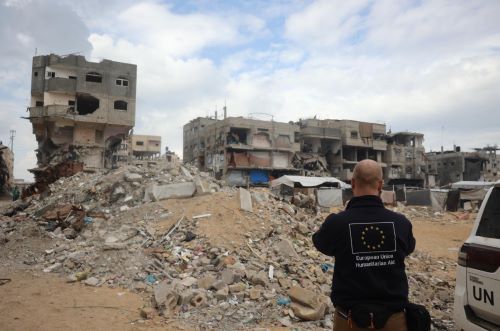
If there is any hope left for international law, it will need to reckon with Gaza. Not just in reports and investigations, but in real enforcement, real justice, and real protections.

By Matthew A. McIntosh
Public Historian
Brewminate
The Promise of Safety in a War without Refuge
In war, certain symbols are supposed to remain sacred. The Red Cross. The white UN flag. The word “aid.” These are not merely markers of presence. They are promises of safety, of neutrality, of reprieve. For civilians caught in conflict zones, they offer the thinnest thread of hope, a signal that someone, somewhere, still believes in the idea of protected humanity.
But in Gaza, that thread keeps breaking.
Over the course of the current war, reports have mounted of Palestinian civilians being killed in or near UN-designated aid distribution points. These are supposed to be sanctuaries. places where people can receive food, water, and medical supplies. Instead, they are becoming scenes of chaos, smoke, and mourning. The very places people flee to survive are being turned into killing grounds.
What remains, then, of humanitarian law when even those symbols lose their power to shield?
The Data behind the Blood
By mid-2025, the United Nations Relief and Works Agency (UNRWA) had confirmed that at least 186 of its facilities in Gaza had been damaged or destroyed since the start of the conflict. Over 180 UN staff members have been killed, one of the highest civilian staff casualty counts in UN history. These are not small numbers. They represent both an operational collapse and a profound ethical crisis.
More urgently, numerous eyewitness accounts and verified footage have documented incidents in which aid seekers were struck while gathering near warehouses, food convoys, or UN-run schools. In one of the most widely publicized events, over 100 people were killed during a chaotic distribution near Al-Rashid Street. Israeli officials initially claimed the deaths were the result of crowd stampedes and looting. Later analysis from international observers, including fragments of munitions and forensic patterns of blast injuries, suggested that live fire had been used.
Human Rights Watch, Amnesty International, and the UN Human Rights Office have all issued statements raising concerns that some of these attacks may constitute violations of international humanitarian law, particularly the principle of distinction, which requires parties to a conflict to differentiate between combatants and civilians at all times.
The Israeli Defense Forces have denied intentionally targeting civilians or aid points. They claim that militants use these sites as cover, hiding weapons or blending into crowds to avoid detection. While that possibility cannot be entirely dismissed, the laws of war demand proportionality. A legitimate military target cannot justify indiscriminate or disproportionate violence, especially not in areas explicitly marked as humanitarian zones.
Historical Echoes and the Erosion of Norms
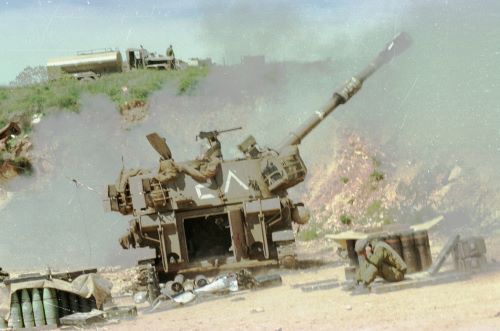
This is not the first time aid centers have come under fire during war. In 1996, Israeli shelling of a UN compound in Qana, Lebanon, killed over 100 civilians sheltering there during Operation Grapes of Wrath. At the time, the international response was swift and condemnatory. Investigations followed. So did formal apologies.
More recently, during the Syrian civil war, hospitals and food convoys in opposition-held areas became routine targets for Russian and Assad regime airstrikes. In Aleppo and Idlib, barrel bombs and cluster munitions were dropped on clinics marked with red crescents. Each strike became a data point in a grim pattern, a slow normalization of war against the infrastructure of survival.
In Gaza, the normalization seems to be accelerating. Each new attack on an aid site is met with brief outrage, followed by silence. The international community condemns. Then it moves on.
What remains unspoken, but increasingly felt, is the possibility that the protection once offered by UN logos and aid markers is being eroded in real time.
The Legal Architecture under Strain
International humanitarian law, rooted in the Geneva Conventions, rests on a few bedrock principles: distinction, proportionality, and precaution. Aid centers, when clearly marked and publicly known, fall into the category of protected spaces. Targeting them directly is a war crime. Causing excessive collateral damage to them during a legitimate military operation also violates the law.
But enforcement has always been the weakest part of this architecture. The International Criminal Court has little jurisdiction when major powers refuse to recognize it. UN Security Council resolutions can be vetoed. Investigations are slow. Accountability is rare.
Israel has long argued that Hamas’s presence within civilian infrastructure blurs the lines of protection. That argument, however, places the burden of danger on the people rather than the belligerents. If Hamas hides among civilians, the legal and moral response is not to strip the civilians of their rights but to find ways to limit harm without collapsing the framework of humanitarian protection altogether.
To fail in that obligation is to declare, even if quietly, that the laws of war are optional.
Hunger as a Weapon, Aid as a Trap
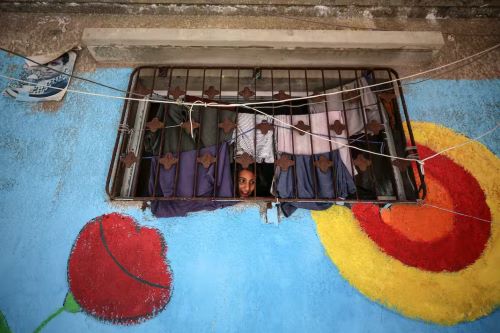
Perhaps the most cynical aspect of the unfolding crisis is that civilians in Gaza are being pushed to the brink of starvation. According to the World Food Programme and other relief agencies, northern Gaza has faced catastrophic levels of food insecurity since early 2024. As of May 2025, at least 1 in 4 households reported skipping meals for multiple days in a row. Malnourished children have appeared in hospitals across the Strip.
When food convoys finally move — often after days of negotiation and only with limited protection, thousands surge toward them. Crowds form around trucks and warehouses not because people are reckless, but because they are desperate. There are no regular supplies. No functioning distribution systems. People come because there is no other choice.
In that context, any attack near an aid site carries more than physical harm. It also carries the psychological message that nothing is safe. That even the hope of bread might lead to death.
To weaponize hunger is already a violation of law. To make the response to hunger a liability is a moral inversion of the humanitarian ideal.
The Vanishing Line between Civilian and Target
In the end, the tragedy of Gaza’s aid points reflects a deeper crisis, the collapse of the distinction between combatant and noncombatant. In a territory as densely populated as Gaza, where entire families live in multigenerational homes and entire neighborhoods collapse under one airstrike, the notion of precision becomes more fiction than fact.
When aid sites are no longer immune. When hospitals are bombed. When journalists are killed in record numbers. The message being sent, intentionally or not, is that no one is safe. And in such a reality, war becomes not just a conflict over territory or ideology. It becomes a conflict over the very possibility of survival.
The international community, already fractured by geopolitical rivalries and diplomatic fatigue, has struggled to respond. Some nations call for ceasefires. Others justify the violence. Still others issue statements and move on.
But history has a long memory. And the images now emerging from Gaza — of children lying beside flattened food trucks, of families sheltering under UN flags now shredded by shrapnel will remain long after the shelling stops.
A Future Built on Ashes or Accountability
The question that hangs over all of this is simple, though difficult: if aid points are no longer safe, then what is? And if the answer is nothing, then what remains of the humanitarian order that once tried, however imperfectly, to put boundaries around war?
If there is any hope left for international law, it will need to reckon with Gaza. Not just in reports and investigations, but in real enforcement, real justice, and real protections for those who have done nothing more than seek shelter from the storm.
Until then, aid sites may continue to operate. But they will do so under the shadow of a terrible truth: that even in war, there are places that should be off-limits, and that the world is failing to defend them.
Originally published by Brewminate, 07.25.2025, under the terms of a Creative Commons Attribution-NonCommercial-NoDerivatives 4.0 International license.
